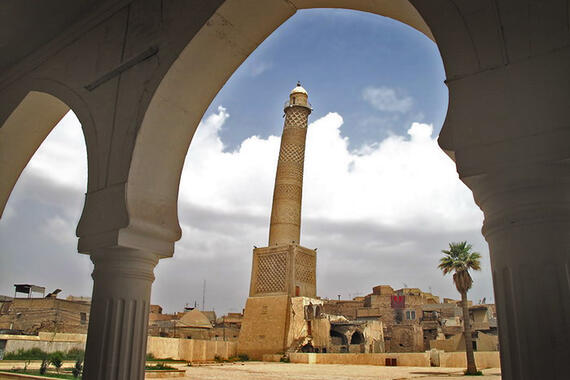An Ignoble End for Mosul’s al-Nuri Mosque and Minaret

The news of the destruction of the 12th-century Great Mosque of al-Nuri and the adjacent al-Hadba Minaret left me speechless. The destruction of sites throughout Mosul over the last three years has made headlines and deepened the pain we feel for those subjected to the violence that has killed countless Iraqi citizens and left a major city in shambles as its residents seek the most basic essentials of food, water, and safety.
No building is ever as important as the people living in a city. The loss of life is the worst news we can hear. Yet it is also heartbreaking to lose remarkable structures and the memory of those who created them. Monuments, libraries, museums, religious traditions, poetry, folk tales, and other embodiments of cultural heritage connect people to the places they live. Our understanding of places is bound profoundly to the people we meet and the appreciation of art, architecture, and cultural traditions that we encounter.
For more than 800 years, al-Hadba Minaret was an essential feature of the Mosul cityscape. I had learned about the history and importance of the complex in which al-Hadba stood in 2009, when the monument was included on the 2010 World Monuments Watch, our biannual list of threatened sites and remarkable conservation opportunities. Our hope was that WMF would find the means to assist Iraqi colleagues with its conservation. The local heritage authority in Mosul was concerned that the minaret was unstable and needed a full engineering inspection. Their hope was that the Watch would bring the necessary resources to address these problems.
Security issues and travel restrictions for WMF personnel prevented access to the site. In 2013 and 2014, I traveled with colleagues to Erbil for WMF initiatives at the Iraqi Institute for Conservation of Antiquities and Heritage, where we were conducting heritage management training courses for Kurdish and Iraqi professionals. A distance of only 50 miles separates Erbil from Mosul, but it was not possible to leave the Kurdish region to visit Mosul due to travel restrictions for foreign national movements to Iraqi Kurdistan to keep control of those moving between the regions. Only a few weeks after I left Erbil, ISIS took control of Mosul.
In the nomination, the minaret is described as of great cultural significance and distinctive due to its intricate brickwork and its leaning silhouette, recognizable to everyone in Iraq.
Perhaps most profoundly as we absorb the news of its destruction, the Office of Antiquities and Heritage in Mosul, the nominator, noted that it should be on the Watch because it had significance to “the State Board of Antiquities and Heritage for its scientific and historic value; to the directorate of Sunni endowments for its religious value; to the local community of Mosul, for its religious, cultural and aesthetic values; and to the international community, for its aesthetic, cultural and scientific values.” These words are true but today seem far too humble to describe a building that witnessed centuries of transformation, growth, and strife in Mosul.
The news today of its loss only makes it more painful that the residents of Mosul have endured a terrible ordeal in recent years as their once thriving city has been a battleground. Mosul is a city renowned for historical and cultural heritage that spans centuries of human achievement. While the destruction of cultural sites in Mosul is first and foremost a loss to the people of Mosul, it is also a profound loss to all of us.
